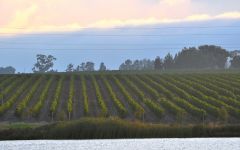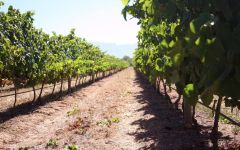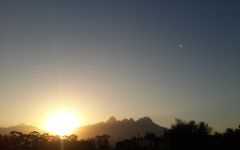Anwilka Red Blend 2016
-
James
Suckling -
Wine
Spectator



Product Details
Your Rating
Somm Note
Winemaker Notes
Deep ruby red in appearance. The nose is upfront with aromas of dark red fruit and oak spice. The palate is bold and elegant, complex yet finely structured. The wine concludes with a persistent and savory finish.
Blend: 55% Syrah, 31% Cabernet Sauvignon, 14% Petit Verdot
Professional Ratings
-
James Suckling
Complex aromas and flavors of dried herbs, tobacco and cedar with some smoke. It’s full-bodied with round, creamy tannins and a savory finish. Rich and intense. This needs another three or four years to soften, but already plush and pretty for a young wine.
-
Wine Spectator
This is savory on the nose with black olive and bay leaf notes, which mix with baked black plum and fig flavors on the creamy palate. Delivers dense, firming and well-knit tannins, with a rich streak of smoky charcoal chiming in on the finish. Shiraz, Cabernet Sauvignon and Petit Verdot. Drink now.







Anwilka Vineyards is located just 4 miles (7 kilometers) from the ocean in Stellenbosch’s prime Helderberg region and is the sister winery to Klein Constantia. The property was purchased in the late 1990s, and extensive replanting of 100 acres (40 hectares) of vineyards comprising primarily Cabernet Sauvignon, Shiraz and some Merlot followed. The then owners Lowell Jooste (the former co-owner of Klein Constantia), along with internationally well-known Bordeaux wine personalities Hubert de Boüard (co-owner of Chateau Angélus in Saint-Émilion) and Bruno Prats (former owner of Chateau Cos d’Estournel in Saint-Estèphe), released the maiden vintage blend of the Syrah-Cabernet in 2005. Anwilka has since established a worldwide reputation for this red blend which has been described by Robert Parker as “the finest red wine I have ever had from South Africa”. Stellenbosch is recognized as the Cape’s premium red wine producing district. The significant maritime influence in the Helderberg sub-region enables exceptional fruit quality. The matching of grape varieties to specific sites was carefully considered when planting the vineyards. Soils are of moderate potential, allowing low vine vigor and consistently healthy vines. A gentle slope assists drainage during the winter rains, so minimal irrigation is used. Good water retention capacity avoids excessive hydric stress. Anwilka strives to produce wines of high quality that express elements of elegance, minerality and balance. As a BWI champion (Biodiversity in Wine Initiative), the winery’s vision is aligned with that of the World Wildlife Fund as they aim to unite conservation and agricultural development in a complementary, mutually beneficial manner. Anwilka continually strives to produce wines in more environmentally responsible and biodynamic ways.

With hundreds of red grape varieties to choose from, winemakers have the freedom to create a virtually endless assortment of blended red wines. In many European regions, strict laws are in place determining the set of varieties that may be used, but in the New World, experimentation is permitted and encouraged resulting in a wide variety of red wine styles. Blending can be utilized to enhance balance or create complexity, lending different layers of flavors and aromas. For example, a red wine blend variety that creates a fruity and full-bodied wine would do well combined with one that is naturally high in acidity and tannins. Sometimes small amounts of a particular variety are added to boost color or aromatics. Blending can take place before or after fermentation, with the latter, more popular option giving more control to the winemaker over the final qualities of the wine.
How to Serve Red Wine
A common piece of advice is to serve red wine at “room temperature,” but this suggestion is imprecise. After all, room temperature in January is likely to be quite different than in August, even considering the possible effect of central heating and air conditioning systems. The proper temperature to aim for is 55° F to 60° F for lighter-bodied reds and 60° F to 65° F for fuller-bodied wines.
How Long Does Red Wine Last?
Once opened and re-corked, a bottle stored in a cool, dark environment (like your fridge) will stay fresh and nicely drinkable for a day or two. There are products available that can extend that period by a couple of days. As for unopened bottles, optimal storage means keeping them on their sides in a moderately humid environment at about 57° F. Red wines stored in this manner will stay good – and possibly improve – for anywhere from one year to multiple decades. Assessing how long to hold on to a bottle is a complicated science. If you are planning long-term storage of your reds, seek the advice of a wine professional.

South Africa’s most famous wine-producing district, Stellenbosch, surrounds the historic town with the same name; fine winemaking here dates back to the late 1600s. Its valleys of granite, sandstone and alluvial loam soils between the towering blue-grey mountains of Stellenbosch, Simonsberg and Helderberg have the capacity to produce beautiful wines from many varieties. The climate is warm Mediterranean, tempered by the cool Atlantic air of nearby False Bay.
Perhaps most well-known for its Pinotage and Bordeaux blends, Stellenbosch also produces noteworthy wines from Syrah, Chenin blanc, Chardonnay and Sauvignon blanc. The district’s wards—Banghoek, Bottelary, Devon Valley, Jonkershoek Valley, Papegaaiberg, Polkadraai Hills and Simonsberg-Stellenbosch—all produce distinctive wines from vines with relatively low yields.
